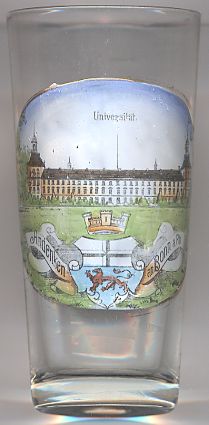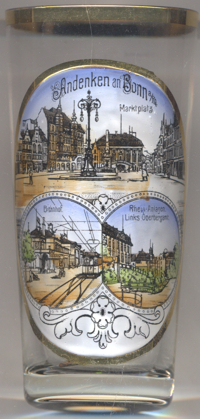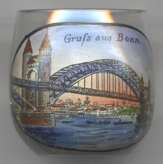

|
| DEUTSCHLAND | GERMANY |
| Bundesland: Nordrhein-Westfalen | North Rhine-Westphalia |
| Regierungsbezirk: Köln | |
| Stadt: Bonn |
Bonn is situated at an elevation of 53 m at the river Rhine in southern North Rhine-Westfalia. From 1949 until 1990 Bonn was the capital of Germany and until 1999 the seat of its government. The city Bonn is divided into 4 city districts (Bonn, Beuel, Bad Godesberg and Hardtberg), each with its own district administration. The city of Bonn has a population of about 314,000 (2005).
 The foundation in 12 BC of a Roman fort called Bonna is usually taken as the origin of the town.
The fort at first only had small dimensions, but after the defeat of the Roman general Publius Quinctilius Varus
against the Germanic tribes under Arminius in the Battle of the Teutoburg Forest in AD 9
(see Bramsche), a whole legion was stationed here.
After the end of the Roman period it took until the 9th/10th century that
Bonn became the spiritual centre. When the Archbishops and Electors of
Cologne were defeated in the Battle of Worringen (1288)
they chose Bonn as their residence. Now being the capital of an important principality,
Bonn was embellished by the archbishops especialy in the 17th and 18th century.
All this ended with Bonn's occupation by French troops in 1794.
The Peace of Lunéville (1802) stipulated that all territories left of the Rhine became
part of France. One year later, the Reichsdeputationshauptschluss declared the secular powers of the archibishops
as lapsed and the territories right of the river Rhine were devided between the duchy of Nassau,
the landgraviate (1806 Grand Duchy) Hesse-Darmstadt and the county of Wied-Runkel.
After the defeat of Napoleon, France had to return the territories and the Congress of
Vienna (1815) decided that all parts of the former electorate (except
the Nassau parts) were incorporated into the kingdom of Prussia (province Jülich-Kleve-Berg,
1822 Rhine province).
The foundation in 12 BC of a Roman fort called Bonna is usually taken as the origin of the town.
The fort at first only had small dimensions, but after the defeat of the Roman general Publius Quinctilius Varus
against the Germanic tribes under Arminius in the Battle of the Teutoburg Forest in AD 9
(see Bramsche), a whole legion was stationed here.
After the end of the Roman period it took until the 9th/10th century that
Bonn became the spiritual centre. When the Archbishops and Electors of
Cologne were defeated in the Battle of Worringen (1288)
they chose Bonn as their residence. Now being the capital of an important principality,
Bonn was embellished by the archbishops especialy in the 17th and 18th century.
All this ended with Bonn's occupation by French troops in 1794.
The Peace of Lunéville (1802) stipulated that all territories left of the Rhine became
part of France. One year later, the Reichsdeputationshauptschluss declared the secular powers of the archibishops
as lapsed and the territories right of the river Rhine were devided between the duchy of Nassau,
the landgraviate (1806 Grand Duchy) Hesse-Darmstadt and the county of Wied-Runkel.
After the defeat of Napoleon, France had to return the territories and the Congress of
Vienna (1815) decided that all parts of the former electorate (except
the Nassau parts) were incorporated into the kingdom of Prussia (province Jülich-Kleve-Berg,
1822 Rhine province).
After World War I, Bonn remained occupied by France until 1926. After World War II, which left about 30% of the town in ruins, Bonn remained in the British occupation zone. Together with Frankfurt am Main, Bonn campaigned for becoming Germany's capital. On 3 November 1945 Bonn was eventually chosen. After the re-unification of Germany in 1990 it was decided to move the capital to Berlin. However, it took until 1999 that the German government could move to the new capital. The city of Bonn now bears the official title "Bundesstadt" ('Federal City'); six federal ministries still have their primary seat in Bonn, the other ministries keep a secondary seat here.
Certainly the most famous native of Bonn is Ludwig van Beethoven who was born here on 16 December 1770.

The main building of the university is the former
 palace
palace

Glass no. 3436 [near left] shows further views from Bonn:
The  Marktplatz (Market Square), today Markt, [top picture]
was created already in the 11th century. Its most prominent building today is the
Marktplatz (Market Square), today Markt, [top picture]
was created already in the 11th century. Its most prominent building today is the
 Old Town Hall
Old Town Hall
[https://de.wikipedia.org/wiki/Bonner_Marktplatz, https://de.wikipedia.org/wiki/Altes_Rathaus_(Bonn)]
The  Bahnhof (railway station) was built in 1844. A new representative building
[bottom left picture] was built in 1883–1884. In 1971 the station was renamed
Hauptbahnhof (Main station).
Bahnhof (railway station) was built in 1844. A new representative building
[bottom left picture] was built in 1883–1884. In 1971 the station was renamed
Hauptbahnhof (Main station).
[https://de.wikipedia.org/wiki/Bonn_Hauptbahnhof]
The  Oberbergamt (mining administration) Bonn [bottom right picture]
was founded in 1816 as a medium-level authority of the Prussian finance ministry. The building originally had been built
as a residence for the Archduke Maximilian Franz of Austria, Prince-elector of Cologne.
In 1830 the building was enlarged by a small annex, and finally replaced in 1901–1903 by a new building on the
same site. It was completely destroyed in 1944 and was rebuilt in 1950 in simplified forms but keeping the original
basic layout. Since the dissolution of the authority in 1970, the building is used by the University of Bonn.
[https://de.wikipedia.org/wiki/Oberbergamt_Bonn]
Oberbergamt (mining administration) Bonn [bottom right picture]
was founded in 1816 as a medium-level authority of the Prussian finance ministry. The building originally had been built
as a residence for the Archduke Maximilian Franz of Austria, Prince-elector of Cologne.
In 1830 the building was enlarged by a small annex, and finally replaced in 1901–1903 by a new building on the
same site. It was completely destroyed in 1944 and was rebuilt in 1950 in simplified forms but keeping the original
basic layout. Since the dissolution of the authority in 1970, the building is used by the University of Bonn.
[https://de.wikipedia.org/wiki/Oberbergamt_Bonn]
 The
The  old Rhine Bridge was built in 1896–1898 as the first brisdge across the river Rhine
at Bonn. The architect was Bruno Möhring. With a width of the main span of 187.92 metres and a total length of
432 metres it was the largest arch bridge at the time. On 8 March 1945, two months before the end of World
War II, the bridge was blown up by the German army. After the war, a new bridge was built using the pillars of the
old bridge. The new bridge was finished in 1949; on 2 December 1963 it was renamed Kennedy Bridge, honouring
US President John F. Kennedy, who had been assassinated 10 days before.
old Rhine Bridge was built in 1896–1898 as the first brisdge across the river Rhine
at Bonn. The architect was Bruno Möhring. With a width of the main span of 187.92 metres and a total length of
432 metres it was the largest arch bridge at the time. On 8 March 1945, two months before the end of World
War II, the bridge was blown up by the German army. After the war, a new bridge was built using the pillars of the
old bridge. The new bridge was finished in 1949; on 2 December 1963 it was renamed Kennedy Bridge, honouring
US President John F. Kennedy, who had been assassinated 10 days before.
[https://de.wikipedia.org/wiki/Alte_Rheinbrücke_(Bonn)]